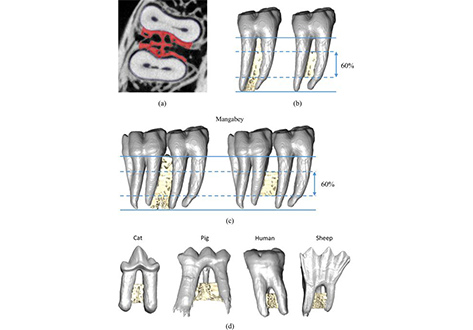Mechanical adaptation of trabecular bone morphology in the mammalian mandible

Alveolar bone, together with the underlying trabecular bone, fulfils an important role in providing structural support against masticatory forces. Diseases such as osteoporosis or periodontitis cause alveolar bone resorption which weakens this structural support and is a major cause of tooth loss. However, the functional relationship between alveolar bone remodelling within the molar region and masticatory forces is not well understood. This study investigated this relationship by comparing mammalian species with different diets and functional loading (Felis catus, Cercocebus atys, Homo sapiens, Sus scrofa, Oryctolagus cuniculus, Ovis aries). We performed histomorphometric analyses of trabecular bone morphology (bone volume fraction, trabecular thickness and trabecular spacing) and quantified the variation of bone and tooth root volumes along the tooth row. A principal component analysis and non-parametric MANOVA showed statistically significant differences in trabecular bone morphology between species with contrasting functional loading, but these differences were not seen in sub-adult specimens. Our results support a strong, but complex link between masticatory function and trabecular bone morphology. Further understanding of a potential functional relationship could aid the diagnosis and treatment of mandibular diseases causing alveolar bone resorption, and guide the design and evaluation of dental implants.